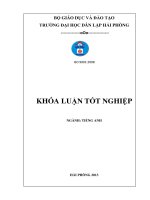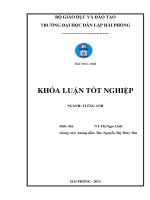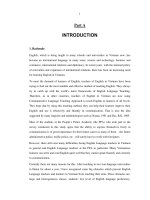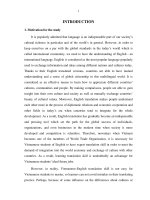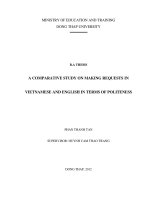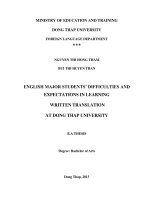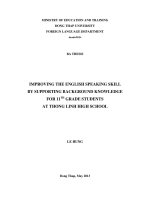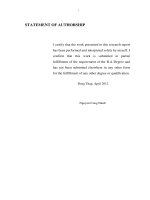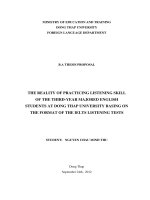b.a thesis english major students’ difficulties and expectations in learning written translation at dong thap university
Bạn đang xem bản rút gọn của tài liệu. Xem và tải ngay bản đầy đủ của tài liệu tại đây (676.68 KB, 104 trang )
MINISTRY OF EDUCATION AND TRAINING
DONG THAP UNIVERSITY
FOREIGN LANGUAGE DEPARTMENT
NGUYEN THI HONG THAM
BUI THI HUYEN TRAN
ENGLISH MAJOR STUDENTS’ DIFFICULTIES AND
EXPECTATIONS IN LEARNING
WRITTEN TRANSLATION
AT DONG THAP UNIVERSITY
B.A THESIS
Degree: Bachelor of Arts
Dong Thap, 2013
MINISTRY OF EDUCATION AND TRAINING
DONG THAP UNIVERSITY
FOREIGN LANGUAGE DEPARTMENT
NGUYEN THI HONG THAM
BUI THI HUYEN TRAN
ENGLISH MAJOR STUDENTS’ DIFFICULTIES AND
EXPECTATIONS IN LEARNING
WRITTEN TRANSLATION
AT DONG THAP UNIVERSITY
B.A THESIS
Supervisor: PHAM VAN TAC, M.A
Degree: Bachelor of Arts
Dong Thap, 2013
iv
TABLE OF CONTENT
Statement of authorship i
Acknowledgement ii
Abstract iii
Table of content iv
Introduction 1
1. Motivation for the study 1
2. Aims of the study 3
3. Subject and scope of the study 3
4. Significance of the study 4
5. Organization of the thesis 4
Chapter 1: LITERATURE REVIEW 7
1.1 Definition of translation 7
1.2 The important of translation 9
1.3 Types of translation 11
1.3.1 Word for word translation 11
1.3.2 Literal translation 12
1.3.3 Faithful translation 12
1.3.4 Semantic translation 13
1.3.5 Adaptation 14
1.3.6 Free translation 15
1.3.7 Idiomatic translation 15
1.3.8 Communicative translation 16
v
1.4 Strategies for translation 18
1.5 Some useful techniques for translation 28
1.5.1 Addition 28
1.5.2 Omission 29
1.5.3 Replacement 29
1.5.4 Transposition 30
1.5.5 Expression 31
1.6 The factors influencing translation process 32
1.6.1 Influence of the mother tongue 32
1.6.2 Words and choice of word meanings 34
1.6.3 Grammatical structure 35
1.6.4 Context 36
1.6.5 Characteristic of language 37
1.7 Common errors in written translation 41
1.7.1 Word order 41
1.7.2 Syntax/ Grammar errors 42
1.7.3 Vocabulary errors 45
1.7.4 Spelling/Punctuation errors 50
1.7.5 Culture errors 52
Chapter 2: METHODOLOGY 54
2.1 Research questions 54
2.2 Research participants: 54
2.2.1 The researcher: 54
2.2.2 The subjects 54
2.3 Research procedure 54
2.4 Data collect instruments 55
2.4.1 The questionnaire: 55
vi
2.4.2 The interview questions: 56
Chapter 3: RESULTS AND DISCUSSION 58
3.1 Results 58
3.1.1 Result collected from the questionnaire 58
3.1.2 Result collected from the interview questions 76
CONCLUSION AND SUGGESTION 80
REFERENCES 89
APPENDIX 91
vii
LIST OF TABLES
Table1: The students‟ interest in studying written translation……………………… 58
Table 2: The reason why students study translation………………………………… 59
Table 3: The students‟ opinions about the usefulness of studying translation……….60
Table 4: Kind of text that students feel difficult to translate…………………………61
Table 5: The biggest challenges that students have to face when translating a passage
from English to Vietnamese ……………………………………………… ….62
Table 6: The biggest challenges that students have to face when translating a passage
from Vietnamese to English……………………………………………… ….63
Table 7: How students will do when they encounter a new word in a
translation text…………………………………………………………………………65
Table 8: How students prepare for new lesson before class………………………… 66
Table 9: What students will do after they finish their translation…………………….67
Table 10: What do students do to improve their translation skill…………………… 68
Table 11: Kind of text students usually practice translation at home…………………69
Table 12: The amount of time students usually spend on studying translation (as self-
study) ………………………………………………………………………… 71
Table 13: Things have a great influence on students‟ interest in translation…………72
Table 14: The topic which students are interested in………………………………….73
Table 15: The students‟ opinion about the influence of teaching method……………74
viii
STATEMENT OF AUTHORSHIP
We guarantee that the thesis entitled “English major students‟ difficulties and
expectations in learning written translation at Dong Thap University” is the result of
our own work. All the statistics as well as the results collected from the data collection
instruments are truthfully reflected by English major students at Dong Thap University
when they first study written translation. The research reported in the study was
approved by Dong Thap University.
Dated: April 20
th
, 2012
Nguyen Thi Hong Tham
Bui Thi Huyen Tran
ix
ACKNOWLEDGEMENTS
It is a great pleasure to thank everyone who helped us write this thesis
successfully.
First and foremost, we would like to express our gratitude to our supervisor –
Mr Pham Van Tac for the valuable guidance and encouragement. He greatly inspired
us to work on this thesis. Our thesis cannot come to end without his effort to read it
again and again to find out the problem and support us in all stages of the research and
writing this study.
In addition, we are grateful to all the professors of the Foreign Language
Department of Dong Thap University for teaching and providing us with a good
environment to study the BA thesis.
We owe sincere and earnest thankfulness to all the students of English class
2011 who provided us valuable information by completing the conveying questions as
well as answering interview questions.
Finally, an honorable mention goes to our families and friends for their supports
on us in completing this thesis.
Thanks for all!
Nguyen Thi Hong Tham
Bui Thi Huyen Tran
English 2009A
x
ABSTRACT
Translation is a new subject for the students of English major at Dong Thap
University. There are two forms of translation: written translation and spoken
translation. At Dongthap University, written translation is taught for the students of BA
English Class from the beginning of the second year. Because translation is still new
and strange for their first time learning, most of the English major students still have
difficulties in learning this kind of subject, especially the students of the second year
from BA English class (2011-2015 curriculums). This study was conducted to find out
the students‟ difficulties as well as their expectations when they begin to learn written
translation in order to make suggestions that can partly help them overcome these
obstacles in studying this course. Besides that, the study also aims at making some
suggestions as a useful reference helping adjust learning and teaching method to get a
better result in learning and teaching process. The research methods used in this study
are the questionnaire- a list of questions to find out the difficulties that students usually
face and the interview questions which used to meeting students‟ expectations in
learning the subject.
1
INTRODUCTION
1. Motivation for the study
No one can deny the importance of language in the process of conveying
information. We all know that language plays an indispensable role in people‟s life and
social development. However, exactly how many languages are there in the world? The
most extensive catalog of the world‟s languages, the ethnologic organization, whose
detailed classified list currently includes 6809 distinct languages. It‟s, therefore, really
necessary to get the purpose of the whole development and interaction. The appearance
of a common language, which can be seen as the second language that all people
around the world can use to exchange ideas with each other in order to meet the
demand of the global standards in the today‟s world, is really pressing. In this
background, English - a universal language at present can be used as the unique tool
satisfying this demand. The role of English is more and more asserted, especially in the
booming age of information and technology. English can be considered as the
prevailing language by the way it dominates every domain and maybe the only
language that truly links the whole world together. The other languages may be
important, yes, but they are only important for their temporary values and they cannot
replace English as an international language in such the way that all people around the
world can use to communicate among countries. We again cannot deny the important
of communicative purposes. Without communication, there is no way to express
thoughts, ideas, and feelings. Furthermore, the business among countries cannot carry
out, so how can the countries as well as the whole world‟s economy develop Without
English, people cannot understand each other more in the process of diplomatic
relation and economic cooperation and many other fields in today‟s era when the
country tend to integrate for the whole development. We cannot list how much benefit
that English brings for us. Its beneficial is unlimited. Therefore, studying English is a
good way to contact with the huge world and approach a boundless source of
information. Also, if we want to survive on this economic developing era, we ought to
2
master English as a demand of job‟s requirements. Today, when every country from
the world overcomes consequences of economic crisis and has a problem with a big
numbers of unemployment, every person needs to push his career forward. By that
way, it is impossible to revalue the importance of English. Its knowledge can get one‟s
dream job in any international company, earn more money and use computer more
effectively, because most computer programs are in English, too.
However, just knowing English is not enough. Sometimes, a person who can
speak, listen and read English does not mean he or she understands it carefully. One
more problem that we have to face here is the necessary of translating skills. When
Viet Nam becomes one of the members of World Trade Organization, it has more and
more requirements for Vietnamese especially students to have expert translation skill to
meet the demand of integration into the huge world economy and to exchange our
culture with other friendly countries. Nowadays, more and more contracts, emails,
news, etc. are on English also, so it is necessary to master translation to translate
documents more exactly in order to avoid regrettable misunderstanding. However, to
master translation is not easy, so not almost all learners can avoid mistakes. When
translating English into our mother tongue, it is not only translating the words we are
reading but also the meaning and the overall purpose of the text as a whole. This can be
very difficult, even for those who are fluent in several languages. As learners, the
researchers assume that almost all learners who begin to study written translation will
meet many difficulties because it is so new and strange for their first time contact, and
there is no exception for students majoring in English at Dong Thap University.
Understanding their difficulties parallel with meeting their expectations can help them
so much in overcoming these obstacles in learning process and create favorable
conditions for the study course. This is the reason we carry out this research with the
hope that the study will be a useful reference helping improve translation skill as well
as understand students‟ difficulties in learning written translation subject. Therefore,
3
students have a suitable project to adjust learning and teaching method to get the best
effective result through the students‟ expectations.
2. Aims of the study
This thesis was done with a view to find out students‟ difficulties in learning
written translation in order to orient students who begin to study this subject in good
manner of study. The study also aims at understanding the students‟ expectation in
learning the subject and then suggesting some possible solutions to overcome
difficulties as well as satisfy their expectations to improve and adjust both learning‟s
style and teaching method.
3. Subject and scope of the study
- Subject: English majored students‟ difficulties and expectations in learning
written translation at Dong Thap University.
- Object: the English majors‟ students who begin to study written translation
at Dong Thap University. They are the second year students in BA classes
(2011-2015 curriculum) and (2011-2014 curriculum).
Translation is a new subject for the students of English major at Dong Thap
University. There are two forms of translation: written translation and spoken
translation. At Dongthap University, written translation is taught for the students of BA
English Class from the beginning of the second year. Because translation is still new
and strange for their first time learning, most of the English major students still have
difficulties in learning this kind of subject, especially the students of the second year
from BA English classes (2011-2015 curriculums) and (2011- 2014 curriculums). This
study was conducted to find out the students‟ difficulties as well as their expectations
when they begin to learn written translation in order to make suggestions that can
partly help them overcome these obstacles in studying this course. Besides that, the
study also aims at making some suggestions as a useful reference helping adjust
learning and teaching method to get a better result in learning and teaching process.
4
4. Significance of the study
Understanding the students‟ difficulties and their expectations in learning
written translation, the thesis will be a useful reference with the solutions suggested
which help the teachers recognize their students‟ requirements as well as expectations
in studying the subject. Since there, having a suitable adjustment in teaching method as
well as teaching material to satisfy the students‟ need, which is believed to bring a
good result in studying. Furthermore, it is a strong hope that the study will be a useful
reference helping improve translation skill for not only the second year students
majoring in English at Dong Thap University but also all Vietnamese people who feel
interested in the job as a translator and really want to become an expert translator.
5. Organization of the thesis
This thesis consists of the following parts:
INTRODUCTION
Chapter 1: LITERATURE REVIEW
1.1 Definition of translation
1.2 The important of translation
1.3 Method of translation
1.3.1 Word for word translation
1.3.2 Literal translation
1.3.3 Faithful translation
1.3.4 Semantic translation
1.3.5 Adaptation
1.3.6 Free translation
1.3.7 Idiomatic translation
1.3.8 Communicative translation
1.4 Strategies for translation
5
1.5 Some useful techniques for translation
1.5.1 Addition
1.5.2 Omission
1.5.3 Replacement
1.5.4 Transposition
1.5.5 Expression
1.6 The factors influencing translation process
1.6.1 Influence of the mother tongue
1.6.2 Words and choice of word meanings
1.6.3 Grammatical structure
1.6.4 Context
1.6.5 Characteristic of language
1.7 Common errors in written translation
1.7.1 Word order
1.7.2 Syntax/ Grammar errors
1.7.3 Vocabulary errors
1.7.4 Spelling/Punctuation errors
1.7.5 Culture errors
Chapter 2: METHODOLOGY
2.1 Research questions
2.2 Research participants:
2.2.1 The researcher:
2.2.2 The subjects
2.3 Research procedure
2.4 Data collect instruments
2.4.1 The questionnaire:
6
2.4.2 The interview questions:
Chapter 3: RESULTS AND DISCUSSION
3.1 Results
3.1.1 Result collected from the questionnaire
3.1.2 Result collected from the interview questions
3.2 Discussion
CONCLUSION AND SUGGESTION
REFERENCES
APPENDIX
7
CHAPTER 1: LITERATURE REVIEW
1.1 Definition of translation
Translation has been various defined. The following definitions have been
selected because they are really typical in some sense; and they can partly raise the
issues, which we are going to pursue in detail later.
Translation is a transfer process, which aims at the transformation of written
source language text into an optimally equivalent target language text, and which
requires the syntactic, the semantic and the pragmatic understanding and analytical
processing of the source language. (Wilss, 1982)
Translation is the expression in another language (target language) of what has
been expressed in one language (source language), preserving semantic and stylistic
equivalences. (Bell.R. , 1991).
Translation is the replacement of a presentation of a text in one language by a
representation of an equivalent text in a second language. (Bell.R. ,1991).
For example, the Vietnamese sentence “Chỉ khi nào thầy giáo cho phép thì sinh
viên mới được vào phòng.” can be translated into English as “Only if the teacher has
given permission are students allowed to enter the room.”
The author continues and makes the problems of equivalence very plain. Text in
different languages can be equivalent in different degrees (full or partly different), in
respect of different levels of presentation (in respect of context, of semantics, of
grammar, of lexis, etc.) and at different ranks (word-for-word, phrase-for-phrase,
sentence-for-sentence).
Translation is the transmission of a thought expressed in one language by means
of another language. The language used to express the thought directly is called the
8
source language, and the language used to translate that thought is called the target
language. (Tu Anh, 2005).
In Vietnamese-into-English translation, the Vietnamese is the source language
and the English is the target language as in the following example:
The source language: “Người bắt đầu học ngoại ngữ luôn luôn gặp khó khăn ngay từ
bước đầu.”
The target language: “Beginners of foreign language always meet difficulties from the
outset.”
In contrast, in English-into-Vietnamese translation, the English is the source
language and the Vietnamese is the target language as in the following example:
The source language: “Due to ill management and protection, forest resources have, in
recent years, been seriously destroyed.”
The target language: “Trong những năm gần đây, do quản lí và bảo vệ kém, tài
nguyên rừng bị tàn phá rất nghiêm trọng.”
Translation is rendering a written text into another language in a way that the
author intended the text. (Bui Tien Bao and Dang Xuan Thu, 1997).
“Translators are concerned with the written texts. They render written texts from
one language into another language. Translators are required to undertake assignments,
which range from simple items, such as birth certificates and driving licenses, to more
complex written materials, such as articles in specialized professional journals,
business contracts and legal documents”. (Bui Tien Bao and Dang Xuan Thu, 1997).
Translation, ultimately, by dictionary definition, consists of changing from one
state or form to another, to turn into one‟s own or another‟s language. (The Merrian –
Webster dictionary, 1974). Translation is a change of form. When we speak of the form
of a language, we are referring to the actual words, phrases, sentences, paragraphs, etc.
9
The forms are referred to as the surface structure of a language. It is a structural part of
a language, which is actually seen in print or heard speech. In translation, the form of
the receptor or target language replaces the form of the source language. But how is
this change accomplished? What determines the choice of form in the translation?
1.2 The importance of translation
Even with the most up-to-date and sophisticated communication system, we can
never know how many languages man used today in the world; let alone how many
languages man has used during the course of his development. Some sources say there
are two or three thousand languages being used in the world, but some others say the
number may be as large as eight thousand. What a habit man has that of speaking
tongues! Thus, he offers himself difficulties and obstacles.
Since communication within often, one community is not enough, certainly.
There has a great number of times arisen a situation in which some individuals are
unable to understand the words or expressions of some others. This phenomenon
creates a barrier to understand whenever man tries to communicate across a great
distance of space or across a great interval of time. Something has to be done to
overcome this restriction. One way to cope with the restriction is for individuals to
know the foreign language. However, this is not the final solution because apparently
no individual in the world can know all the languages in use. The best polyglot so far
knows only about twenty-five languages. Let us make a comparison between the
number 25 and 8000; it is a very numerous distance between the languages that this
polyglot can use and the number of languages that exist in the worlds.
Still people want to read what other people want to write and what people say,
translation and interpretation may be considered as the most universally accepted
solution for surmounting the obstacles. Thus, there is a need for professional translators
and interpreters. (Bui Tien Dao and Dang Xuan Thu, 1997).
10
Stuart stated that translation as the product of language learning projected onto
an interlanguage framework. Therefore, translation skills should be evaluated
according to the state of learners‟ interlanguage in any state of its development. (Stuart
Campbell, 1980).
Translation is a real-life, natural activity and increasing necessary in a global
environment. Many learners living in either their own countries or a new one need to
translate language on daily basic both formally and informally. This is even more
important with the growing importance of online information.
Translation can support for the writing process, especially at lower levels.
Research has shown that learners seem able to access more information in their own
language, which they can then translate. (Stuart, Campell, 1980).
The research totally agrees with the above ideas. When the human language
appears, translation becomes necessary and significant. Imagine that one day you have
a trip visiting a green and beautiful oasis. Unfortunately, you get lost from your group
and you have not done any research about this oasis before; you do not know any
information about the people as well as their language and many other things related to
this place. At that time, a crowd of inhabitants appears, and you are excited and happy
to say “Hello” to them with a friendly face. Suddenly, they bit you. You fail to
understand anything and try to escape this place. Later, when you spend time doing
research to find out what “Hello” means in this oasis, you realize that the word “Hello”
in this oasis sounds like “I will destroy you!”. On a serious note, translation is one of
the most critical jobs in modern society. Translation becomes more and more important
when all countries in the world have exchanged and cooperated in variety aspects like
culture, education, business, etc. However, no one has enough ability to translate;
therefore, we need to have translation.
In order to meet the demand of this multilingual world‟s whole development, it
is required an appearance of a common language that all of countries in the world can
11
use. Nowadays, English has been used as the universal language all over the world. In
our country, English play an indispensable role in the economic aspect. Especially
when Viet Nam has become member of World Trade Organization, the demand to have
expert translation is necessary. It is true that all of the contracts, emails, agreements, or
conventions, etc, in English need to be translated exactly and effectively to avoid some
regrettable misunderstandings.
1.3 Types of translation
1.3.1 Word-for-word translation:
Here the source language (SL) word is translated into another language by their
most common meanings, which can also be out of context at times, especially in
idioms and proverbs.
- The following are the characteristics of this approach:
+ SL word order is preserved.
+ Words are translated by their most common meanings, and out of
context.
Ex: He is a big liar.
Anh ta là một lớn nói dối.
Or: Mời bạn về nhà tôi chơi.
Invited friend about my house play
- This kind of translation used for:
+ Information about SL
+ Language learning (mechanics of language)
+ Pre-translation process of difficult text in order to gain the sense of
meaning
12
1.3.2 Literal translation
Here the SL grammatical constructions are translated to their nearest language
(TL). A literal translation sounds like nonsense and has little communicative values.
- The following are the characteristics of this approach:
+ Lexical words are translated singly, and out of context.
Ex: He is a big liar
Anh ta là một kẻ nói dối lớn.
He looked up at the Milky Way
Anh ta nhìn lên con đường màu sữa.
- This kind of translation used for:
+ Pre-translation process to identify problems
+ Basis of poetry translation for poet who does not understand SL
1.3.3 Faithful translation
Here the translation interprets the exact contextual meaning of the original
within the constraints of the grammatical structures of the TL.
- The following are characteristics of this approach:
+ Words are translated in context but uncompromising to TL.
+ Transfer cultural words
+ Does not naturalize
+ Often read like a translation
Ex: He is as fast as a kangaroo.
Nó nhanh như một con kanguru.
- This kind of translation used for:
+ Literary translation
13
+ Authoritative texts
+ Drafts
1.3.4 Semantic translation:
Semantic translation refers to that type of translation, which takes into account
the aesthetic value of the SL text.
- The following are the characteristics of this approach:
+ More flexible than faithful translation
+ Naturalize a bit while faithful translation is uncompromising (but in order
to achieve aesthetic effect), for instance, it may translate cultural words
with neutral or functional items.
+ Great focus on aesthetic features of source text (at expense of meaning if
necessary).
+ Close rendering of metaphors, collocations, technical terms, slang,
colloquialisms, unusual syntactic structures and collocations, peculiarly
used words, neologism, badly written or inaccurate passages.
- This kind of translation used for:
+ Texts that have high status, e.g., religion texts, legal texts, politicians‟
speeches
+ Expressive texts, e.g., literature
Ex
1
: “Right in the heart of Ha Noi, Hoan Kiem Lake is an enchanting body of water, a
peaceful oasis away from all the hustle of the city.”
“Nằm ngay giữa trái tim Hà Nội, hồ Hoàn Kiếm là một hồ nước đẹp mê hồn, một
ốc đảo yên bình tách biệt với sự hối hả bận rộn của thành phố.”
Ex
2:
Life is never easy. So whatever comes to destroy you, stay firm and be the bravest
as you can. You might cry, be upset, but never lose hope; and most especially, never
give up because GOD is always there, here and forever.
14
“Cuộc sống không bao giờ đơn giản và dễ dàng. Vì vậy, dù có bất cứ điều gì tồi tệ
xảy đến, hãy cứng rắn và dũng cảm lên. Bạn có thể khóc, có thể buồn nhưng đừng bao
giờ đánh mất hi vọng và quan trọng nhất là đừng bao giờ từ bỏ hi vọng vì Thiên Chúa
luôn ở bên cạnh bạn và mãi mãi bên bạn.”
1.3.5 Adaptation:
The text is rewritten considering the SL culture which is converted to the TL
culture where the characters, themes, and plots are usually preserved.
- This kind of translation is used mainly for plays and poems.
Ex:
Melody Angel 27 September 2004 (from “The Grant Piano”)
What feeling do I borrow?
Sometimes I am happy
Sometimes I am sad
I can feel my heart
Telling me I feel bad
First I‟m up there
First I‟m down here
I‟m holding my fear
But it‟s hard to hear
What I sing today
Is what I feel tomorrow?
Cảm xúc nào tôi đang mượn
Có những lúc trong tôi là hạnh phúc
Có những lúc sầu muộn lại đong đầy
Trái tim tôi tâm sự với tôi đây:
Tôi thấy xấu, buồn đau và khổ ải!
Đang trên cao cảm thấy lòng thoải mái
Bỗng ngờ đâu phút chốc lại vơi đầy
Sợ hãi nào tôi đang giữ trong tay
Nó giẫy giụa, quấy rầy cho tôi khổ
Tôi đang hát một bài ca nào đó
Lời nhạc này – cảm giác của ngày mai
15
I can hear my thoughts
“What I am to borrow?”
My feelings change
Nearly every minute
I can feel my heart
Still holding fear in it
Tôi đang nghe trí óc tôi tâm sự:
Cảm giác nào cần phải mượn nữa đây?
Dẫu biết rõ cảm xúc tựa gió mây
Luôn luân chuyển vô thường trong mỗi
phút
Tôi thương cảm trái tim tôi nhỏ dại
Nhịp đập nào thiếu vắng nỗi lo đây?
(dohop – phỏng dịch từ tiếng anh)
1.3.6 Free translation:
Free translation reproduces the matter without the manner, or the content
without the form of the original. It is a kind of meaning-based translation and usually a
paraphrase much longer than the original.
Free translation focuses on the content of the target text rather than the form,
which means that the same content is expressed in the target text but with very
different grammatical structures if need be.
Ex: Business is business.
Công việc là công việc, tình cảm là tình cảm, không thể lẫn lộn được.
1.3.7 Idiomatic translation:
It translates the message of the original text but tends to disort the original
meaning at times by referring colloquialisms and idioms. (Su, 2003)
16
Idiomatic translation makes use of idioms and colloquialisms that are not
present in the source text.
It is asserted that the original meaning of a fixed combination is not equal to the
sum of the meaning of separate words.
Ex: Out of sight, out of mind
Xa mặt cách lòng.
Wait and see.
thời gian sẽ trả lời.
No guide, no realization
Không thầy đố mày làm nên.
1.3.8 Communicative translation:
This method displays the exact contextual meaning of the original text in a manner
where both content and language are easily acceptable and comprehensible to the
readers.
- The following are the characteristics of this approach:
+ Bee freer than semantic translation
+ Give priority to the effectiveness of the message to be communicated
+ Focus on factors such as readability and naturalness
+ Both the content and the language are readily acceptable and
comprehensible to the reader.
- This kind of translation used for informative texts.
Ex: a small conversation between friends
